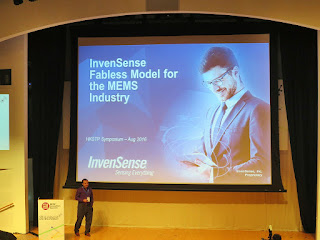The
APAC Innovation Summit series was a flagship innovation conference of Hong Kong
Science and Technology Parks Corporation (HKSTPC) and the topic entitled
“Sensors” was held on 25 August 2016. APAC
Innovation Summit (“AIS” in short and formerly known as InnoAsia) aimed to
provide an exchange platform on the trend of specific technology sectors. In the beginning, Dr. HL Yiu (Head of
Electronic Cluster, HKSTP) gave a welcome speech and he pointed out that sensor
played an important role in different field under smart city and robotic. He hope todays keynotes would give some
insight for all participants.
The
first speaker was Prof. William C. Tang (University of California, Irvine) and
his topic entitled “Micro-electromechanical Systems (MEMS) Technology and
Applications”. Firstly, he reviewed IEEE
publication from 1995 to 2015. He
observed that the publication in Circuits decreased in percentage and Sensors
increased as much as Circuits in 2015.
Then he briefed the MEMS advantages included Integration,
Miniaturization and Batch Fabrication. It
included Anisotropic Wet Etching of Silicon, Surface Micromachining, Deep
Reactive Ion Etching (DRIE), TI Digital Light Processor and Accelerometer.
Prof.
Tang briefed some applications on sensor included Automative Sensor and Smart
Phone Sensor. However, Biomedical
Applications would be the one of key areas using Sensor. Those application for better tools on Drug
Delivery, Monitoring, Bio-analyses, Prosthesis and Minimally Invasive Surgery. Bio-sensor separated In-vitro and In-vivo
Sensors.
Prof.
Tang briefed some applications on sensor included Automative Sensor and Smart
Phone Sensor. However, Biomedical
Applications would be the one of key areas using Sensor. Those application for better tools on Drug
Delivery, Monitoring, Bio-analyses, Prosthesis and Minimally Invasive Surgery. Bio-sensor separated In-vitro and In-vivo
Sensors.
The
second speaker was Ms. Clarie Troadec (Yole Développement)
and her presentation named “MEMS & Sensors for Smart Cities”. In the beginning, Ms. Troadec briefed her
company’s business models included “Consulting and Analysis”, “Reports”, “Financial
Services” and “Media”. MEMS &
Sensors was one of their 30 analysts operated areas. She said Smart City was key facts to employ
sensors. The definition of Smart City
was “Resilient, Safe, Sustainable and More Connected” (The United Nations
Economic Commission for Europe - UNECE).
Ms.
Troadec introduced MEMS was a semiconductor technology thus enabling
miniaturization and lower cost manufacturing of existing products. She predicted gas sensors as the next MEMS
success. Then she summarized the technologies of IoT as following diagram.
After
that she identified three important hubs for Smart Cities included Inertial,
Environmental and Optical. However, she
focused on Environmental hub using different gas sensors because she believed
the gas sensors became more and more important due to global air quality
deterioration, new regulations and new technology development that combined
multiple sensors in a single package.
During
the tea break, some incubatees demonstrated their sensor product such as
eNano.
The
third speaker was Dr. Mike Daneman (InvenSense, Inc) and his topic was “Fabless
Model for the MEMS Industry”. Firstly,
he reviewed MEMS markets by applications included Automotive, Consumer,
Industrial and Telecom. It was found
that Consumer product employed in highest percentage. His
company was founded in 2003. They had
unique technology and Intellectual Property (IP).
Then
Dr. Daneman introduced their Fabless Business Model and they employed TSMC for
twice shuttles per year. He told us the
advantages of wafer-level integration included Low Parasitics, Minimize Routing
& External Interconnect, Wafer Level Sealing/Packaging, Testing and
Designed for Test. The benefit of
application from CMOS integration included High Sensitivity, Complexity,
Integration, Low Cost and Small Size.
Finally,
Dr. Daneman briefed InvenSense Shuttle Processess included Standard (SOI)
Shuttle and Piezo Shuttle. He summarized
that InvenSense Shuttle was bringing the CMOS fabless model to MEMS industry so
as to increase MEMS value through system integration and reduce time to market.
Prof.
Muhammad Mustafa Hussain (King Abdullah University of Science & Technology,
Saudi Arabia) was the fourth speaker and his presentation topic was “Skin Like
Multi-Sensory Platform for Bio and Environmental Applications”. He
said his research on smart skin was inspired from human skin
functionalities. Prof. Hussain said the
trend would be the development of E-skin towards Paper Electronics.
He
quoted one example from Advanced Materials’ Paper Skin – 3D Multi-Sensory
Platform. The sensors would include
Temperature, Humidity, pH, Pressure, Force / Tactile Sensing, Flow & Proximity
Sensing, Matrix Simultaneous, etc.
Finally,
he summarized the E-skin sensors characteristics and found that it had higher
performance and functionality per cost compared with existing electronic artificial
skin. He concluded paper skin was the
first demonstrated an affordable and customizable lightweight health monitor
artificial skin.
Prof.
Wen J. Li (City University of Hong Kong) was the last speaker and his
presentation entitled “Intelligent Sensors for Cyber Physical Human Systems”. In the
beginning, Prof. Li introduced himself with research experience in CUHK, Shenzhen
Academy of Robotics and CityU. Then he
mentioned the important characteristics of Cyber Physical Systems (CPS) which
directly connected between the physical and digital world with new systems
functions through information, data, and function integration. (e.g. Google car) Then he introduced Cyber Physical Cities and
one testing city was in Longgang which was intelligent and green city.
Then
Prof. Li briefed the future factories should be IT systems built around
machines, storage systems and supplied that were linked up as cyber-physical
systems (CPS). He also quoted Cyber
Physical Farms as example.
Prof.
Li also mentioned different example employed CPS and one of interested sampel
was Palpation Sensing Robotic Han to measure rate and regularity of human pulse
for simulating Chinese Medicine Practitioner (CMP) fingers. Lastly, Prof. Li summarized that the
development of Cyber Physical Systems technology was a key driver for the “4th
Industrial Revolution” and new paradigms for industrial and manufacturing
engineering would be created. MEMS and
Nanotechnology were fundamentally important he said. In future, highly interdisciplinary among
robotics, sensors, modelling, virtual reality, wireless communication, system
engineering, control, computer science and biomedical engineering would be new
direction of CPHS research and education.
Reference:
20141203:
HKSTP APAC Innovation Summit 2014 - http://qualityalchemist.blogspot.hk/2014/12/hkstp-apac-innovation-summit-2014.html
20150642:
HKSTP APAC Innovation Summit 2015 - Robotic - https://qualityalchemist.blogspot.hk/2015/06/hkstp-apac-innovation-summit-2015.html

















沒有留言:
發佈留言